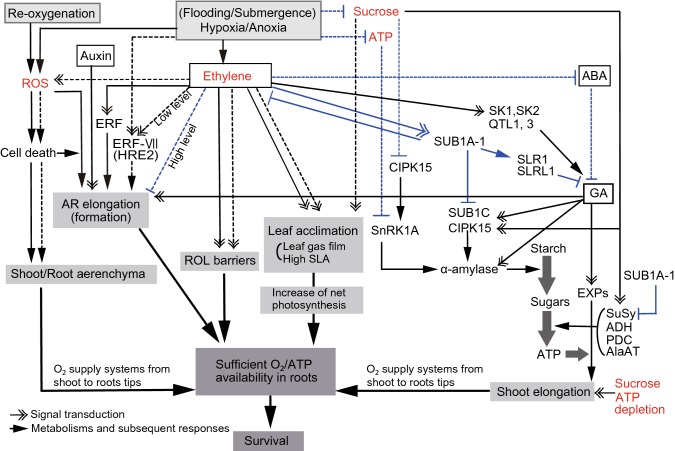Fig. 4.
Characteristics of low O2 escape strategy (LOES) and low O2 quiescence strategy (LOQS) to hypoxia/anoxia caused by flooding/submergence in wetland and terrestrial plants. Black solid and dashed lines are the networks of LOES (aerenchyma formation, shoot elongation, radial O2 loss (ROL) barriers, and leaf acclimation) in wetland and terrestrial plants, respectively, while blue dashed lines indicate responses to suppress LOES in both plants; blue solid lines indicate the submerged regulatory network of LOQS in rice (wetland species). Four key factors, ROS accumulation, ethylene content, ATP depletion, and sucrose reserve decrease, involve the LOES and LOQS networks are shown in red letters. ROS production in hypoxic and anoxic stresses causes programmed cell death (PCD) in both plant types and involves the mechanisms of adventitious roots (ARs) emergence and aerenchyma formation. AR elongation in Arabidopsis (terrestrial plant) is promoted by the hypoxia signal and its formation is mediated by hypoxia-responsive HRE2, which is one of the group VII ethylene response transcription factors (ERFVIIs). High ethylene level inhibits the AR formation in Arabidopsis under hypoxic condition, although ARs are formed at low ethylene level. In contrast, in rice plants, ethylene has promotive effects on the AR formation and elongation. The contrasting regulation by ethylene on ARs may reflect different adaptive strategies in the flood-tolerant rice plants compared to the flooding-intolerant terrestrial species such as Arabidopsis. Leaf acclimation such as high specific leaf area (SLA), reoriented chloroplasts along with cell wall in leaf epidermis, thin cuticles and cell walls, development of dissected leaves underwater, and the maintenance of gas films can increase the net photosynthesis by decreasing the diffusion resistance for CO2. The leaf plasticity could also result from the accumulation of ethylene and a decrease in CO2 levels. Flooding/submergence causes ethylene accumulation, which triggers gibberellin (GA)-promoted cell elongation through the expansins (EXPs). In deep-water rice with LOES, ethylene promotes the induction of SNORKELs (SKs, SK1, and SK2) and GA elevation and the internodes of the shoots elongate rapidly to come out of the water surface. In the deep submergence lines of rice with LOQS, ethylene activates the submergence 1A-1 (SUB1A-1) promoting an increase in SLENDER RICE 1 (SLR1) and SLENDER RICE-Like 1 (SLRL1) transcription factors, which inhibit GA-mediated activation of gene expressions. This LOQS characteristic of rice can limit carbohydrate consumption by inhibiting shoot growth. Wetland plants develop shoot and root aerenchyma, ROL barriers, and elongated shoots elongation and these characteristics of LOES act synergistically with each other in enhancing the stability of O2 and ATP availability in roots where nitrogen (N) uptake and active N assimilation take place. Abbreviations are as follows: ABA, abscisic acid; ADH, alcohol dehydrogenase; AlaAT, alanine aminotransferase; CIPK15, calcineurin B-like interacting protein kinase 15; HRE2, hypoxia-responsive ERF 2; PDC, pyruvate decarboxylase; QTL1 and 3, quantitative trait loci on chromosomes 1 and 3; SnRK1A, sucrose non-fermenting receptor kinase 1A; SuSy, sucrose synthase; SUB1A-1, submergence 1A-1

